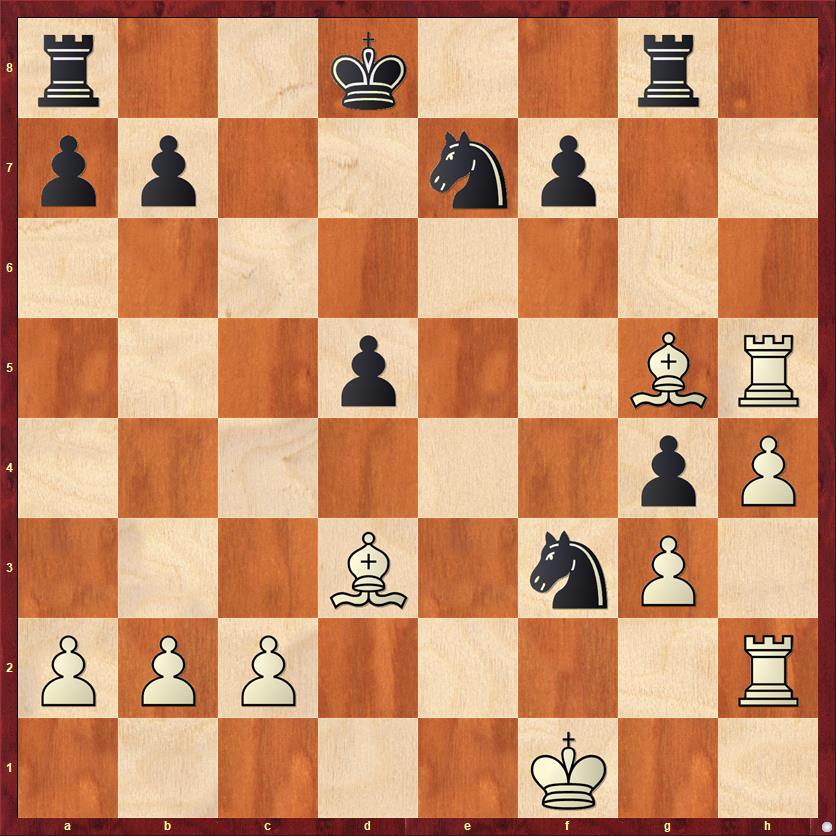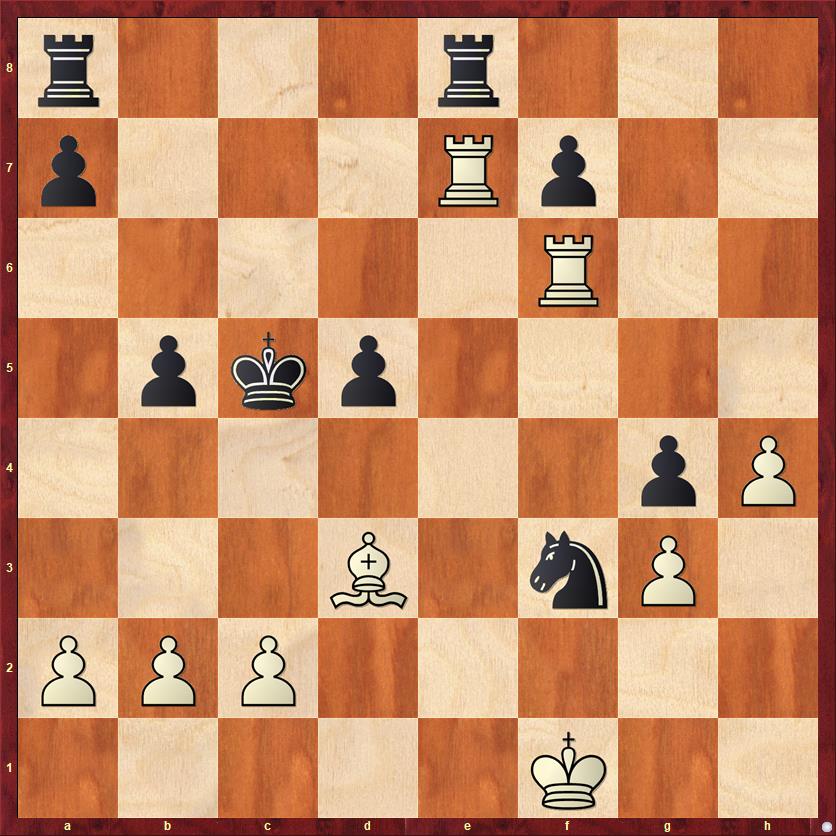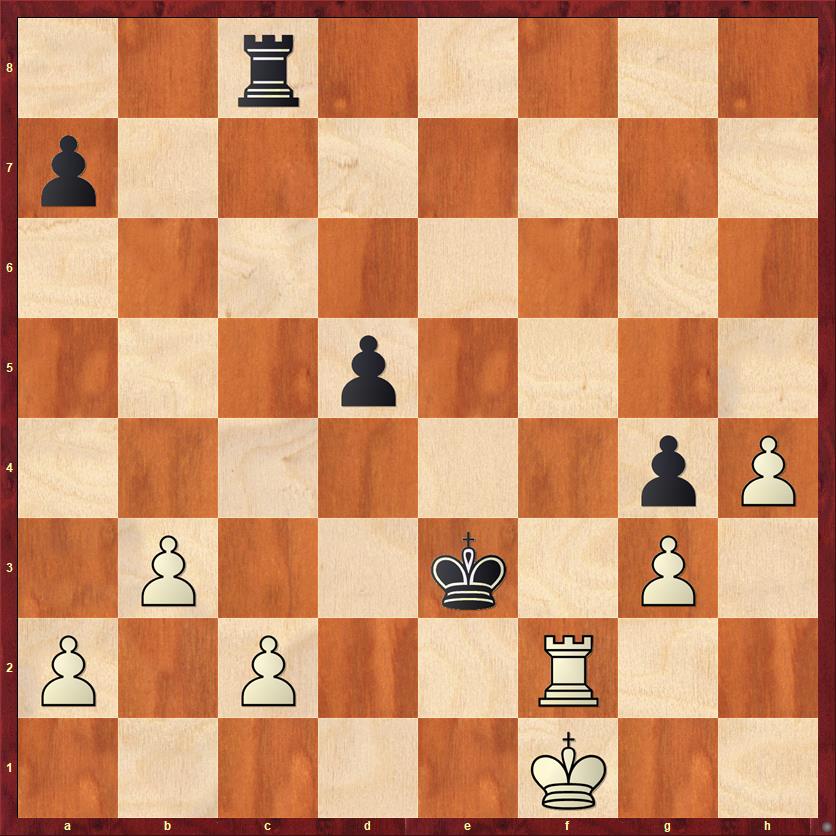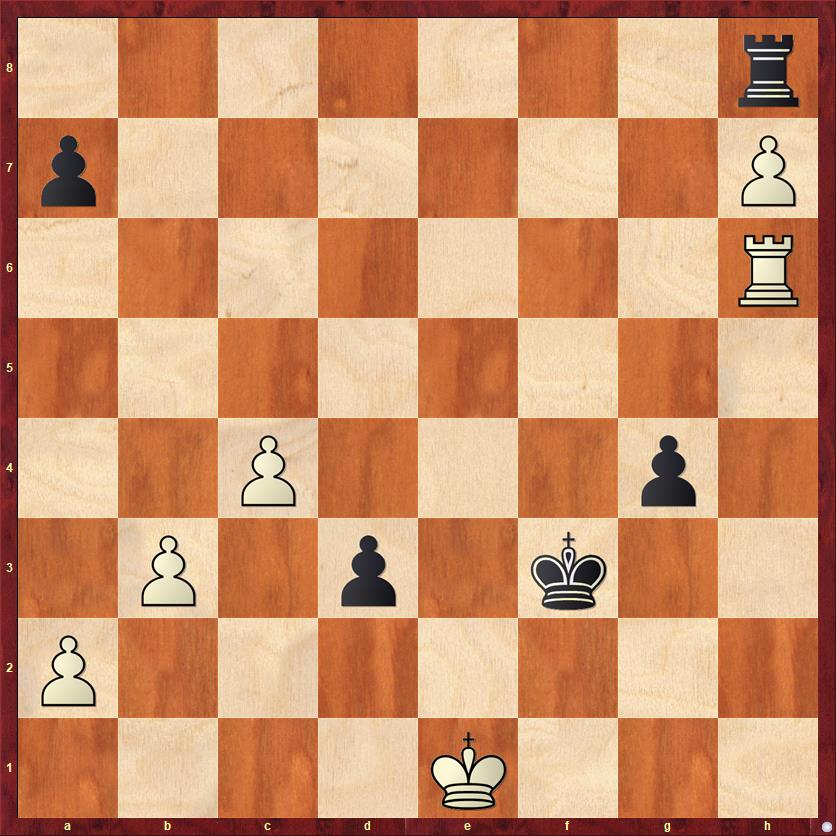First, an update on the U.S. Amateur Team West championship results. In my last post I knew that we had tied for second but I didn’t know for sure how the tiebreaks worked out. Now I can tell you that we in fact finished third, which is great! Third place gets hardware (commemorative clocks with plaques), while fourth place gets nothing… unless you win one of the many other prizes offered (best chess club, best scholastic team, best college team, best family team, etc.)
I’d like to show you another of my games from the tournament, from round five. It was noteworthy because I got to a position with a huge advantage, 4 pawns according to the computer, but then I blew it and had to settle for a draw. In my current win streak (9 wins and 2 draws in my last 11 games), I’ve done a pretty good job of finishing off my opponents when I got to a won position. Not this time! The way I failed, though, makes for a good lesson.
Let’s start on move 25, where the silliness begins. I’m playing White, and my opponent, Nicholas Jiang, is an expert who is currently the #65 13-year-old in the United States. I played the King’s Gambit, which I strongly suspect he had never faced before. He tried to hold onto the gambit pawn, didn’t succeed, and in the position shown he is in big trouble, with his king stuck in the middle of the board, weak pawns all over the place, and my rooks much more active than his.

FEN: r2k2r1/pp2np2/8/3p2BR/6pP/3B1nP1/PPP4R/5K2 w – – 0 25
The one good thing about this position for Black is the knight on f3. I didn’t want to allow him to take on g5 and double my pawns, because I really liked the passed pawn on h4 and thought that it would eventually win the game for me. So I played
25. Bxe7+ Kxe7 26. Re2+ Kd6 27. Rh6+ Kc5!?
This move startled me, because it gives me serious chances to checkmate him. But Black is already lost, so why not try to create a little havoc? On the more conservative moves, 27. … Kd7 or 27. … Kc7, Black’s multiple pawn weaknesses are going to kill him.
28. Rf6 b5 29. Re7 Rge8

FEN: 6r1/pp2kp1p/2p5/7n/3rP1pP/3B2P1/PPP3K1/R4R2 b – – 0 22
In every other game this tournament, when I got to a position like this, I found the move that was like a dagger to my opponent’s heart. In this position I have such a move. Do you see what it is?
If you haven’t figured it out yet, here is a huge hint: close the mating net. That’s how you catch a wandering king: first encircle, then attack him directly. The clearly best move is 30. c3!! Notice that this threatens mate in two different ways: Rc7+ or b4+. Thus Black does not have time to capture the rook on e7. Also note that 30. … d4 doesn’t work because of 31. b4+ Kd5 32. Be4+ Kc4 33. Rc7 mate — a rather unconventional mating pattern! In fact, Black’s only way to not get checkmated is to play the difficult-to-find 30. … Nd2+ 31. Kg2 d4, where the knight now defends the e4 square and makes the above checkmate impossible. But Black’s forces are very disorganized, and the simple 32. Rc7+ Kd5 33. Bxb5 should win easily.
Unfortunately, I failed to find the brilliant move and played the more routine
30. Rc7+? …
This should still win, but it is not the way to hunt a wandering king. First cut off the king’s escape route, then chase. If you chase first, you will just chase the king into a good position.
30. … Kd4 31. Rf4+? …
Now this is an out-and-out blunder. There is still time to shut Black’s king out with 31. Kf2. While it was perhaps forgivable that I overlooked the remarkable 30. c3!!, this mistake is not forgivable. The move 31. Kf2 is not remarkable, unusual, or hard to find. When you are winning, priority #1 is to defuse your opponent’s counterplay. I somehow just had a blind spot for the power of Black’s next move.
31. … Ke3!
The king is no longer a joke. It gives Black the equivalent of an extra piece. Note, incidentally, that the g-pawn is immune because of 32. Rxg4?? Nh2+.
32. Rfxf7 Ne5 33. Bxb5 Nxf7 34. Bxe8 Rxe8 35. Rxf7 Rb8! 36. b3 Rc8 37. Rf2 …

FEN: 2r5/p7/8/3p4/6pP/1P2k1P1/P1P2R2/5K2 b – – 0 37
It’s amusing that I breathed a huge sigh of relief when I got to this position. Finally, I thought, everything is defended, and I’m two pawns up, so I should be winning.
Not so! The more you look at the position, the more you realize that White has almost no way to make progress. If Kg2 my rook literally has no good moves. If Rh2 Black can play … Kf3 and my g-pawn is suddenly in peril.
The only winning attempt I could find was pushing my passed h-pawn, but it’s not enough.
37. … d4 38. h5 Rc6 39. Rh2 Kf3 40. h6 d3!
A nice shot — obviously I can’t take because of … Rc1 mate. Now I will have two ultra-dangerous passed pawns to contend with, the d-pawn and the g-pawn.
41. c4 Rc8 42. h7 …
The computer points out a very interesting idea for White that I scarcely even considered: 42. Rf2+!? Kxg3 43. h7 Kh3! 44. c5! The point is that White gets both his c-pawn and h-pawn going. After extremely long computer analysis it looks like a draw, too, but it was a better attempt for White than the game variation.
42. … Rh8 43. Ke1 Kxg3 44. Rh6 Kf3, draw?!

FEN: 7r/p6P/7R/8/2P3p1/1P1p1k2/P7/4K3 w – – 0 45
Here Jiang offered me a draw. In my last post I criticized him for “throwing his teammates under the bus.” You’ve got to remember that this was a team competition. His team was behind, 2-1, so offering me a draw was equivalent to resigning the match for the whole team.
Maybe my criticism was too harsh. The computer shows the position as 100 percent drawn, with many different drawing variations. I would likely have played 45. Kd2 g3 46. Kxd3, and now it’s important to realize that after 46. … g2 White has an easy draw with 47. Rf6+. Black cannot escape the checks without either giving up the g-pawn or stepping in front of it.
But what if White plays for a win? In that case it’s also a draw. Here’s a sample line, courtesy of the computer: 45. Kd2 g3 46. Kxd3 g2 47. Rg6?! Rxh7 48. c5 Rh1 49. c6 g1Q 50. Rxg1 Rxg1 51. Kd4 (only move; 51. Kc4?? Ke4 would be a win for Black) 51. … Rc1 52. Kd5 Rc2 53. Kd6 Rxa2 54. c7 Rc2 55. Kd7 Ke4 56. c8Q Rxc8 57. Kxc8 a5 58. Kb7 Kd4 59. Kb6 Kc3, draw.
I think that in this situation, in a team competition, if there is even a glimmer of a hope that your opponent might miscalculate, or that you might steal a tempo somewhere and win, you should give it a try.
However, Jiang’s possibly premature draw offer should not take away from the fact that over the board, he defended his position magnificently. He wasn’t afraid to launch his king into the middle of the battlefield, and ultimately his king put my cowering monarch to shame. The game is, in fact, an excellent example of a theme I’ve written and lectured on before: how to save lost positions. Sometimes you can do it with a lucky swindle, but more often you save lost games by creating one little problem after another for your opponent, until they add up to a big problem. Good game, Nicholas Jiang!
As for me, the disappointment of blowing what looked like an easy victory was eased greatly by the fact that I scored the half-point that our team needed to win the match.



{ 1 comment… read it below or add one }
As I was watching your game online, I wondered why , after he played Rg8 in the opening, you played g3. At the time I thought g4 was stronger, preventing the queen trade and winning material. A few moves later I understood that the position with queens off is clearly much better for White, I thought you showed great judgment.